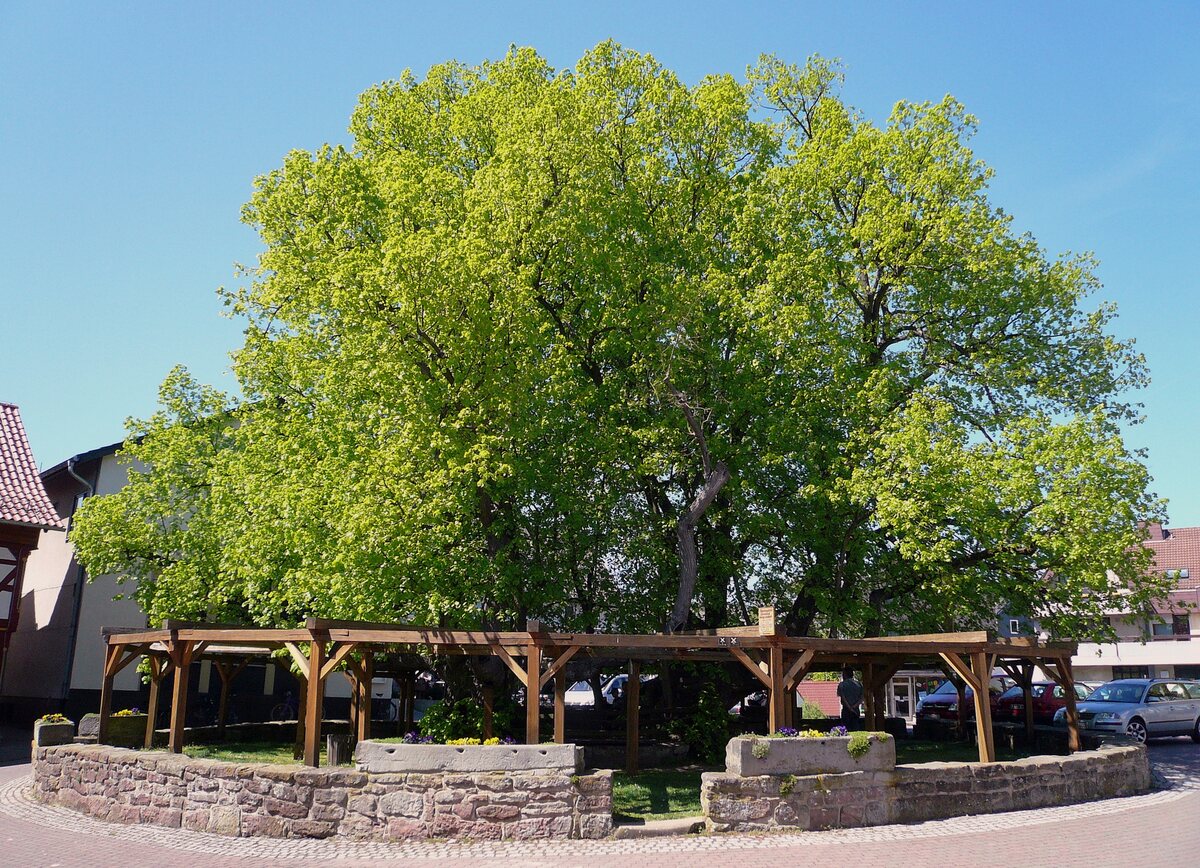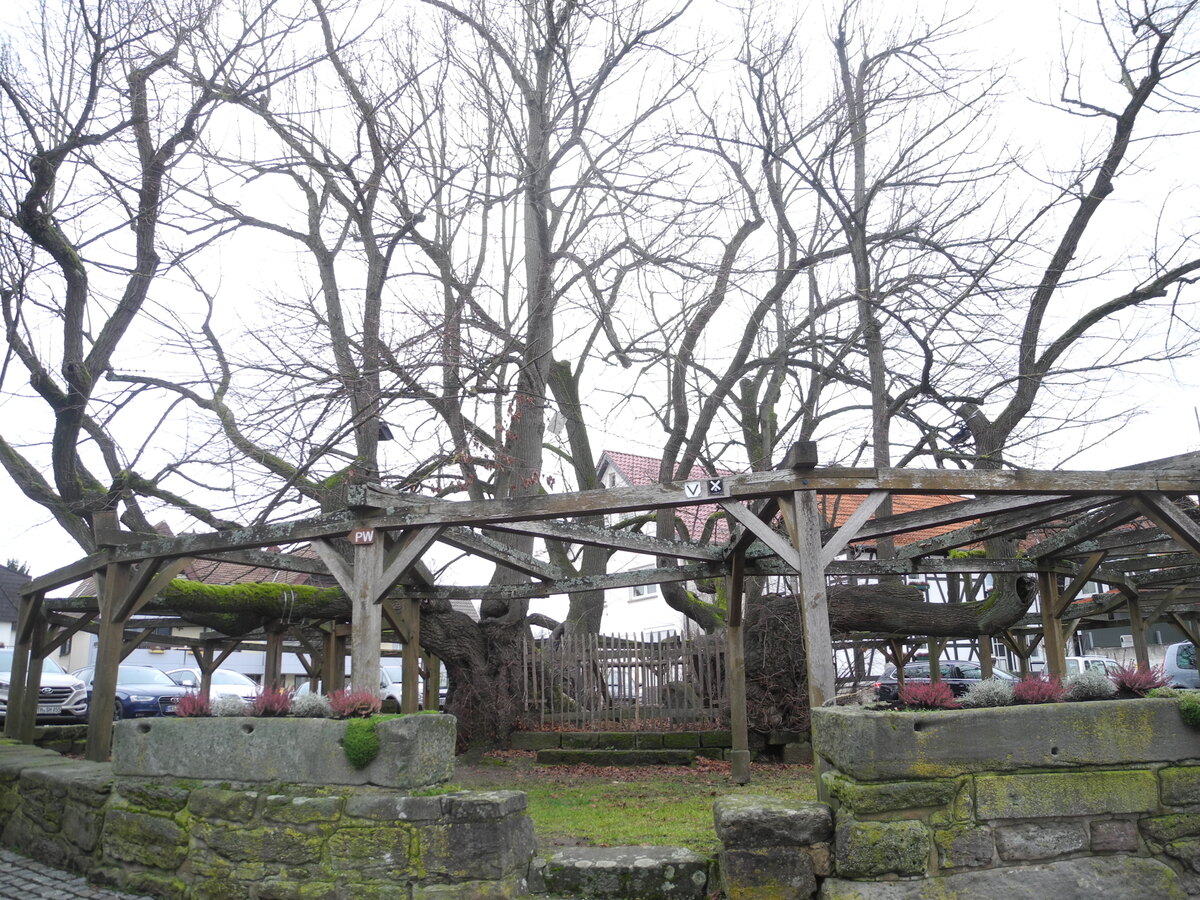Wonder
Schenklengsfeld Lime

 In short
In short
Technically the largest tree by the circumference in Germany is Schenklengsfeld Lime. Its 17.8 m are measured around four separate trunks that stand around an empty place where was the center of the former trunk. But the history of this tree is even more impressive – for long centuries it served as a local court.
 38.5%
38.5%
GPS coordinates
Location, address
Name in German
Alternate names
Species
Circumference
Height
Age
Map of the site
If you see this after your page is loaded completely, leafletJS files are missing.
 In detail
In detail
In the center of Schenklengsfeld village stands an enormous, much revered tree – the legendary Schenklengsfeld Lime. This tree might be the oldest tree in Germany and it has the biggest trunk circumference in the country.
Description

Today the lime has four separate trunks, each leaning away from the center and each some 3 meters in circumference. According to a legend the tree was divided by lightning. Between these trunks is an empty place with an area of a small room – the former middle of the trunk. Current parts of the tree still have a common root system.
There is a possibility, though, that this tree consists of several separate trees that grew closely together and have formed a joint root system.
The height of the tree is around 13 m but the crown has a diameter of almost 25 meters.
At the height of 1 m the circumference of all parts is around 17.91 m but at the height of the least circumference (close to the ground) – 17.8 m. Thus, formally, this is the thickest tree in Germany even if it does not look like a single tree.
Current estimates of its age differ – some sources mention the age of 600 years, others – 1 275 years. Seems, there is no way to find out its real age.
History and legends
In the center of the tree, where long, long ago was the middle of its trunk, now stands a stone with an inscription “Planted in 760 AD”. According to some local accounts, the stone was made by a local teacher in the 20th century. In 760 AD was constructed the local chapel and, according to local legends, a tree was planted then as well.
It is possible that in this location was also a spring – now there, under the tree stands the historical St. Georg’s Well.
Gerichtslinde
In 1557 the Schenklengsfeld Lime started to serve as a court. It was a German tradition during medieval times to hold the court outside the buildings under the sky. Large trees were convenient for such purposes to save from the sun and rain. In most cases, large lime trees served for such purposes as lime trees were considered to have magical properties. Such court limes – ‘Gerichtslinde’ exist up to this day in rather many locations around Germany. The last execution took place under another tree – Göttinger Gerichtslinde on January 20, 1859.
Schenklengsfeld Lime was the official location of the court until 1796 and occasionally also in the 19th century. There was also a pillory under it.
Place of festivities and protected monument
Schenklengsfeld Lime was not just the site of gruesome executions – it was a popular place for festivities and country fairs.
This tradition continues up to this day and every two years in June there is organized a festivity – Lindenblütenfest, as well as other festivities.
The tree is a protected natural and historical monument since 1926 at least. Local community takes care of the lime – it is healed, and watered in dry summer time.
The Schenklengsfeld Lime still marks the central square of the village. The tree is surrounded by two low stone walls and its branches rest on a special wooden construction that was made around 1900 or even earlier and has been maintained since then.
References
- Dorflinde in Schenklengsfeld, Baumkunde.de. Accessed on May 19, 2023.
- Sommer-Linde ‘Tanzlinde Schenklengsfeld’ auf dem Marktplatz in Schenklengsfeld, Hessen, Deutschland
, Baumkunde.de. Accessed on May 19, 2023.
 Linked articles
Linked articles

Wonders of Germany
Germany has a picturesque landscape and rather many natural landmarks, but these are overshadowed by the rich and diverse cultural heritage. From time to time immense values have been lost in warfare, but Germans have duly rebuilt their cultural treasures and are constantly creating new values.

Trees
The category includes some of the most impressive and interesting separate trees in the world. The total number of tree species in the world still is a wild guess – maybe 10,000 and maybe 100,000 but most likely somewhere in between. Every month there are reported new tree species from the whole world, including Western Europe.

Wonders of Europe
The heritage of Europe is diverse and endlessly interesting. Incomparably rich is the wealth of European historical architecture, but this part of the world has exciting natural heritage and archaeological heritage as well.
 Recommended books
Recommended books
Oak: The Frame of Civilization
Professional arborist and award-winning nature writer William Bryant Logan deftly relates the delightful history of the reciprocal relationship between humans and oak trees since time immemorial―a profound link that has almost been forgotten. From the ink of Bach’s cantatas to the first boat to reach the New World to the wagon, the barrel, and the sword, oak trees have been a constant presence throughout our history.
Collins Tree Guide
This illustrated field guide, by David More and Owen Johnson, covers the trees of Britian and non-Mediterranean Europe.


